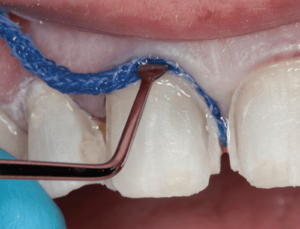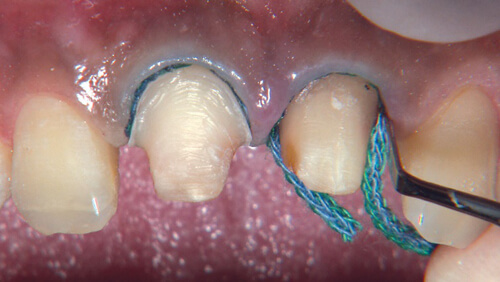A retraction cord is a special dental material that is used during the process of taking impressions in order to manage the gingival tissue and get the ideal impression. The quality of restorations depends on a good impression so retraction cords can do a lot to provide that.

Retraction cords are cords, that are placed in the gingival sulcus so that dentists can get a good impression of the teeth and the surrounding tissues. When dentists prepare the teeth for a fixed restoration such as a crown, bridge or even veneers, they have to remove a part of the dental tissue. They do that until they reach the cervical area of the tooth. After a certain amount is trimmed, the tooth gets a new shape that is supposed to provide good retention of the restoration. The area where the preparation ends and the non-trimmed part of the tooth starts is called a gingival finish line or margin. That is one of the most important parts of the whole process of making restorations. This is the line where the crown will start when placed on the tooth. It should be a perfect match with the gingival margin so that there is no leakage of gingival fluid, saliva and there is a perfect appearance. When dentists take impressions it is very important that the gingival margin is visible. Most of the times, that line is located inside the gingival sulcus and it’s covered with gingiva. That is why dentists need to find a way and separate the gingival tissue so that the impression material can reach the margin. They do it by using a retraction cord. There are many types of impression techniques and impression materials, but getting a visible margin is a priority for all of them. Retraction cords are usually used with a special liquid that comes in a bottle. This is a hemostatic liquid that prevents bleeding and provides a clear and visible field. There are also pre-soaked cords available on the market. Some dentists even use a double retraction cord technique, when they place two cords inside the sulcus for an even better visibility.
When dentists need to get an impression for a fixed restoration, they do it with two different types of materials. The first one is a light-body material, while the second one is a medium-bodied. The light-body material should get into the sulcus and properly get an impression from the margin.

Types:
Retraction cords can be braided or knitted. According to most dentists, braided cords are easier to work with and to apply with special packing instruments. When it comes to the knitted ones, they have the tendency to double in size when placed in the sulcus, and really open it. There is no good or bad type of retraction cord, it mostly depends on the knowledge and the preference of the dentist. They come in different sizes, lengths, and diameters. It also depends on the dentist whether they will decide to soak them in the hemostatic liquid or not.





